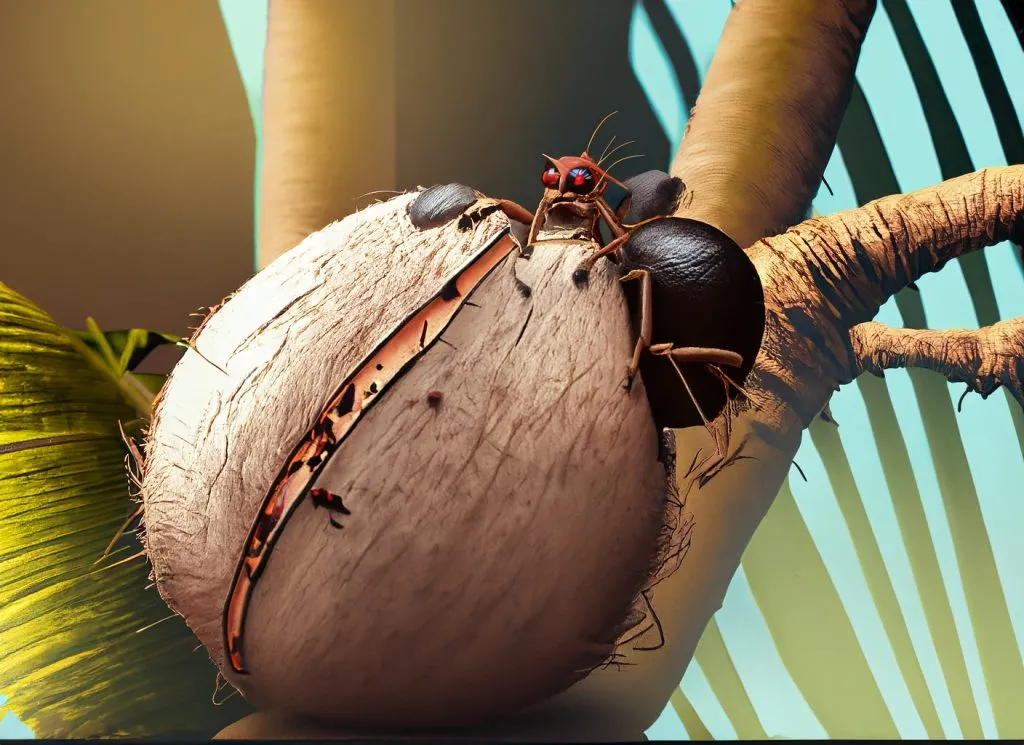Coconut Worms: Culinary, Medicinal, and More
Coconut worms, primarily comprising the rhinoceros beetle larvae and the palm weevil larvae, inhabit the interiors of coconut trees. These worms are not only notable for their role in certain global cuisines, especially in places like Vietnam, but also for the sustainable farming potential they present. The act of farming coconut worms offers possible environmental advantages, such as reducing food waste given that they thrive on decaying plant matter. Moreover, they can be raised without the dependency on pesticides or herbicides, promoting a more organic and environmentally-friendly agricultural approach.
Impact on Coconut Trees:
Tree Damage:
These worms, technically referred to as larvae, tunnel their way into the soft parts of the coconut tree, especially targeting young trees that are more vulnerable. As they bore into the trunks, they disrupt the transport of vital nutrients and water within the tree. This infestation, if not identified and managed in time, can lead to stunted growth, yellowing of leaves, and a reduced yield of coconuts. Prolonged infestation can also weaken the tree structure, making it susceptible to breaking or falling during strong winds.
Disease Transmission:
Coconut worms, by themselves, pose enough of a threat to coconut trees. However, the damage is exacerbated when considering that their tunneling activities provide easy access for various pathogens. These entry points become hotspots for fungal and bacterial infections, which can further harm the tree. Moreover, the moist and protected environment inside these tunnels offers an ideal breeding ground for these pathogens, making the tree’s internal system a war zone of pests and diseases. As a result, an infested tree can quickly deteriorate in health, show signs of distress, and eventually die if not treated promptly.
For Humans:
Edible Delicacy:
In Southeast Asia, particularly countries like Vietnam and Thailand, coconut worms are a sought-after treat. They are often marinated and paired with alcoholic beverages, making them a popular choice in local taverns. Their unique, slightly chewy texture combined with a somewhat sweet and nutty flavor has made them a gastronomic delight among locals and adventurous tourists alike.
Nutritional Benefits:
Besides their delicious taste, coconut worms offer substantial nutritional value. They’re a powerhouse of protein, essential for muscle growth and repair. The amino acids present aid in various bodily functions, from supporting neurotransmitters to assisting in wound healing. The beneficial fats in these worms also contribute to healthier skin and hair.
Medicinal and Other Uses:
Traditionally, people have consumed coconut worms not just for their taste but for their perceived medicinal qualities. They are often cited in traditional recipes as a remedy for fatigue and to increase stamina. The high protein content is also leveraged in rural areas as livestock feed, especially for poultry, enhancing the nutritional profile of the animals’ diet.
Safety:
While they are safe to eat, it’s important to ensure that coconut worms are sourced from clean environments and are adequately prepared before consumption. Avoid consuming them raw, as they might carry pathogens. Always cook or roast them properly to ensure safety. And, as is the case with all exotic foods, it’s advised to eat them in moderation and be attentive to any allergic reactions.
Management:
Ensuring the health of coconut trees requires monitoring and managing these pests. Regular checkups and preventive measures can reduce potential damage.
Conclusion:
Coconut worms, with their rich history in gastronomy and traditional medicine, are truly a fascinating subject. As the world tilts towards sustainable food practices, there’s potential for coconut worms to be recognized as an eco-friendly food source. With proper farming practices, these worms could pave the way for sustainable gastronomy, providing both nutrition and fulfilling eco-responsibilities. Have you ever tried them, or would you consider giving them a taste in the future? We would love to hear from you! If you found this article intriguing, don’t hesitate to leave a comment or share it on your favorite social media platform.

